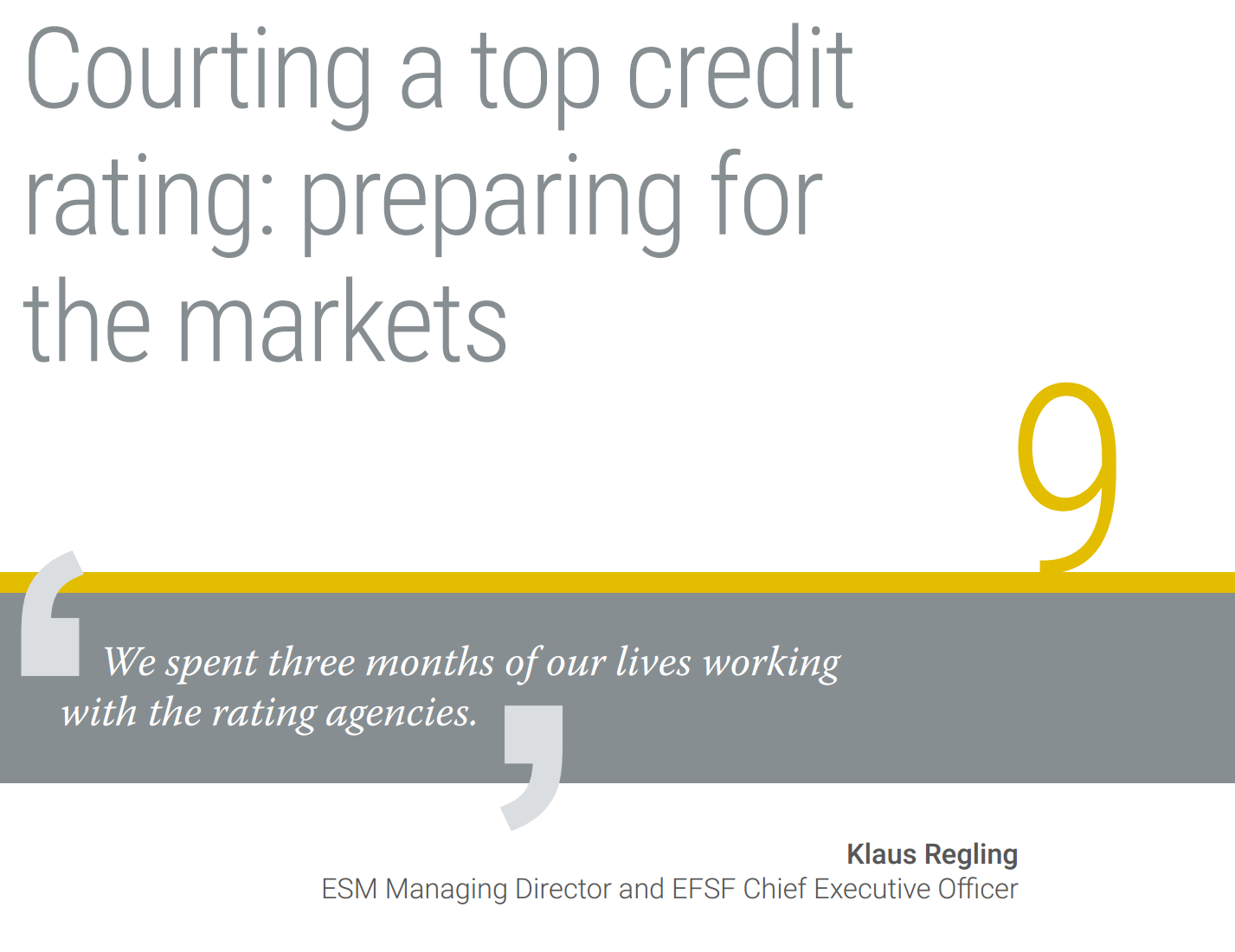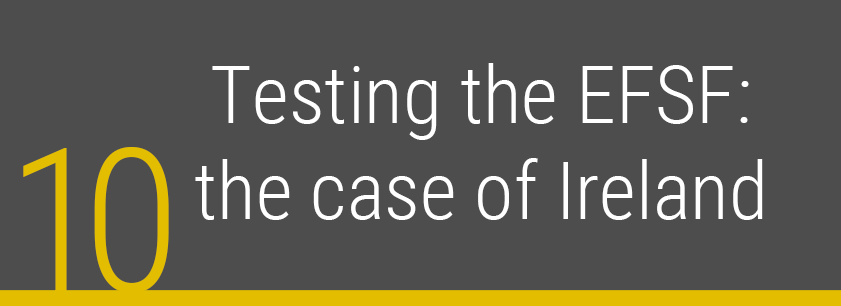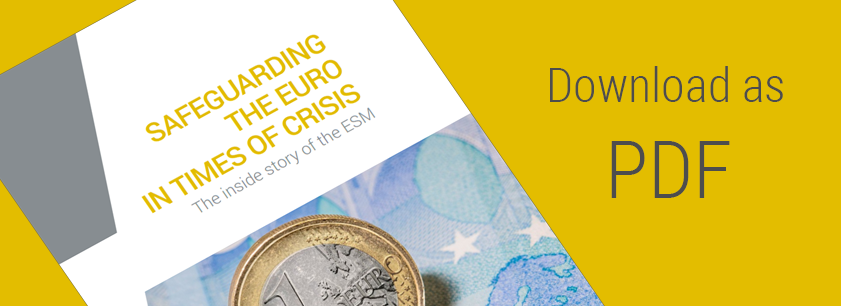9. Courting a top credit rating: preparing for the markets

With the creation of the EFSF, euro area member states found an innovative way to support one another, despite the dents in mutual trust. However, before the fledgling EFSF could raise a cent on the capital markets, it needed the endorsements of three large credit-rating companies that advise on what much of the market is willing to buy, sell, and hold: Moody’s, Standard & Poor’s, and Fitch.
Heading into the second half of 2010, getting the debut credit ratings for the new euro area fund would be the priority for EFSF CEO Regling and Chief Economist Strauch. A top rating was essential to keep issuing costs as low as possible – and to establish a good global reputation.
The rating agencies, which act as a go-between to help investors assess the risks of different issuers, were the central players in this process. For the new and untested EFSF, investors needed the external assurance that only a top rating from the three big agencies would afford. Banks, pension funds, and insurance companies have internal rules that often forbid investing in debt unless it meets strict rating requirements.
‘It was essential that the EFSF have a good credit rating,’ said den Ruijter, then an officer in the Dutch finance ministry and now one of the ESM’s risk officers. ‘Because the EFSF was going into the market to lend to countries no one else would, it needed to be absolutely credible.’
Obtaining a gold-standard rating, generally known as AAA, is difficult for any borrower because it certifies an issuer as one of the lowest-risk investment propositions. In general, a AAA grade is associated with fiscally sound sovereigns seen as virtually default-proof. Investors who buy highly rated securities receive a promise of safety, and in exchange they accept lower interest returns than they would get by entrusting their cash to riskier endeavours. If the EFSF were to secure a top rating, it could borrow from the markets at low rates.
On the other hand, in creating the firewall, the euro area had set up a new kind of financial structure. Nothing like it had existed before: a private company, with public guarantees from several governments, that issues debt on capital markets to provide loans to countries that had lost market access. The EFSF’s closest equivalent is the EU’s EIB, which also turns to the capital markets to raise funds, but unlike the EFSF has both subscribed and paid-in capital to stand behind its bonds. The EFSF would be borrowing strictly on the strength of euro area guarantees.
‘It was very hard for the rating agencies to understand,’ Strauch said. ‘Also for investors, it took quite some education to get there because it was completely new.’
The novelty meant the rating agencies could not rely on benchmarking against other such organisations, part of their traditional toolkit. They needed to commit time and resources to analysing the new EFSF, which in turn had to explain itself in painstaking detail. It fell to Regling and Strauch to ensure the rating firms understood the mechanism so that the EFSF could get the AAA it sought.
‘Neither Klaus nor I had any primary rating experience, so getting a rating for a new unknown institution that has a complex structure was a challenge,’ Strauch said. The German Finance Agency, which would handle the EFSF’s initial borrowing operations, sent reinforcements. The duo then turned to a US investment bank for advice as they set about trying to convince the big three rating agencies that the EFSF would be a worthy borrower.
But good advice wasn’t enough to get a high-quality rating overnight. ‘We went out and tried to get it. We didn’t get it in the first round,’ Strauch said.
As he and Strauch went back to the drawing board, Regling was fully aware that the EFSF faced more than the usual challenges. And he needed no reminding of the delicate nature of the credit rating situation, having just wrapped up his analysis of the causes of the Irish crisis and the global financial crisis more generally, in which he found fault with the rating agencies for taking a sometimes cavalier approach.
In A preliminary report on the sources of Ireland’s banking crisis, Regling and Watson, his co-author, spoke plainly: ‘[…] rating agencies, the custodians of security assessment, dropped their guard, at best.’ They added that the core problem was ‘their readiness to classify as Triple-A, or close to Triple-A, complex securities based on re-packaged assets’[1]. In other words, Regling and Watson had accused the agencies of giving away the AAA rating lightly.
This put the new, untried EFSF in an uncomfortable position when pursuing that same rating. ‘That was particularly tricky, because we wanted a AAA after criticising them for two years that they had given away the AAA too easily. They had promised to become stricter, but now we came along saying: “But we are different. We want a AAA,”’ Regling said.
The process had two stages: the EFSF had to gain a provisional issuer rating first, and then secure a final rating with the specifics of the security due to be sold. This required an elaborate presentation, along with draft documentation, explanations of the fund’s guarantees, and other details of how the programme would work.
Each rating company had its own procedures. Moody’s, for example, outlines a nine-step process that kicks off with a meeting to collect data[2]. This is analysed and condensed into a recommendation made to an internal review board, whose decision is then made public. Follow-up monitoring is continuous. Standard & Poor’s has requirements including quantitative and qualitative data, ranging from historical and projected financial information, peer comparisons, governance framework, financial strategy, to the experience and credibility of management[3]. Fitch carries out yet another approach, looking at the big picture and running various due diligence checks[4].
As the process got underway, questions poured in from analysts across the rating agencies’ departments – structured finance, banking, sovereign ratings, and of course international financial institutions. All sought assurances that requirements in their areas would be met.
‘I remember, for example, they would put out the standards for us, the structures for the guarantee mechanism that would be in line with their requirements for some structured finance products,’ Strauch said. ‘You had to go detail by detail to make it work from their perspective.’
The analysts wanted to know how the EFSF’s capital call mechanism would work, the possible time periods involved, each country’s individual requirements for being informed, and who should pay what if the capital got called in. It was also important to sort out to whom bond investors could turn in a default and when the money could be collected.
‘All that was completely new and had to be reviewed,’ Strauch said. The combined effect of negotiating each small detail could get ‘very tedious’.
In particular, the agencies wanted to understand the guarantees from euro area member states that support the EFSF. These guarantees provide assurance to investors that the fund is underpinned by credible sovereign issuers with a long history of reliable public borrowing. The EFSF has no capital of its own – a key compromise in the temporary fund’s design. Instead, euro area member states back the bonds the EFSF issues. And because the member states don’t put up any cash – with the exception of a small start-up contribution – the structure protects euro area taxpayers from direct exposure to the programme countries.
Under the EFSF’s initial design, it had €440 billion in guarantees, equal to its intended lending capacity. This structure paved the way for the EFSF to win approval from euro area governments: the guarantees backed the EFSF’s marketable borrowing, not the loans to the programme countries. It represented a diplomatic coup at a moment when the euro area needed urgent action.
However, as the EFSF approached the markets, the guarantees went under the microscope. Regling explains: ‘The rating agencies wanted to know how strong the legal certainty is. Because if a government after an election in 10 years says, ‘I don’t care what my predecessors did a decade ago. We will ignore these guarantees,’ then the system would collapse. It’s set up in a way that this cannot happen. These guarantees cannot be withdrawn. They are watertight. But this had to be proven, so lawyers from the different rating agencies had to look into the legal systems of each euro area country.’
The initial plan was that all euro area countries would pool their reputations, with the reasoning that any group on this scale, and including so many wealthy countries, would be enough to impress the markets.
But not so fast. Investors quickly deduced that if, say, Portugal was having trouble borrowing on its own, its share of the guarantees wouldn’t count for much. This was one of the first hurdles in the quest for a top rating, which became more of an odyssey than expected.
‘It became clear relatively soon that what we aimed for – AAA – would not fly,’ Strauch said. Under the EFSF’s original design, the initial feedback was not even good enough for an AA-range rating, and that certainly wasn’t going to cut it for the firewall’s debut. At that point, the give-and-take kicked into a higher gear. ‘They give you feedback and say if you want to get an AAA then you need to do these things – and eventually that is what we did,’ Strauch said.
A key problem was that rating agencies would not count guarantees from countries whose sovereign debt was not itself rated AAA towards the EFSF’s AAA borrowing capacity. At the time the EFSF was set up, about 60% of member states had ratings lower than AAA.
‘We had to rethink the structure,’ Strauch said. ‘It all boiled down to the need to get some cash in the box, some assets somewhere to back our issuance.’
The first step to shore up the EFSF’s creditworthiness was for euro area members to increase the size of the guarantees. The countries therefore agreed in June 2010 to guarantee up to 120% of each bond issuance instead of just the face value[5]. This additional guarantee was a step in the right direction but wasn’t enough to satisfy the questions from the rating agencies.
The next step was to add a cash cushion created by extra borrowing, on top of what was needed for programme disbursements. This scheme effectively led to the EFSF retaining about 27% of the cash receipts from the bonds issued. Alongside the member state guarantees, the cash buffer would reassure the markets and act as an effective credit enhancement of the issued bond.
In practical terms, this meant higher costs for countries that entered programmes during this period. The first two countries with EFSF programmes – Ireland and Portugal – had to pay fees and interest on all the cash borrowed on their behalf, not just the amount available to them in disbursement[6]. But, at the same time, the overguarantee structure made it possible for EFSF loans to go ahead.
‘It was expensive for the programme countries because you needed to over-issue a lot,’ Strauch said. Nonetheless, an EFSF programme using this approach was still cheaper than the alternative of foregoing the AAA rating, because it allowed the EFSF to tap the market at a lower cost of funding.
As the team put these plans into practice, different models were considered in hopes of finding a technical solution that would meet all of the varied requirements.
Something had to give, and that turned out to be the EFSF’s €440 billion total capacity. The overguarantees would work, but the trade-off was that they reduced the EFSF’s lending capacity to around €250 billion, a lot less than the initial EFSF topline.
‘We amended the structure but at the expense of the volume,’ Strauch said. Only when the member states opted in 2011 to increase the overall guarantees to €780 billion and the overguarantee to 165%[7] of the issued amount, up from the 120% agreed in 2010, would the fund’s full €440 billion capacity become available.
Former German Finance Minister Schäuble said the guarantee increase became possible after EFSF Members accepted the ‘basic idea’ that Members with an AAA rating assumed some responsibility for the other guarantors. ‘As a result, it was possible to pass on favourable interest rates to the programme countries, which were largely disconnected from the capital markets. This gave them the time they needed to carry out reforms. In that respect, we backed the EFSF model,’ Schäuble said.
As the EFSF evolved, it became less reliant on maintaining a top rating at all times, and the euro area was able to lower the interest rates charged to programme countries. But in the early days, the negotiations to map out the full extension of the guarantee system were needed to start the fund off on the right footing. Later on, the ESM, with its paid-in capital structure, would do away with some of the limitations inherent in the EFSF’s guarantee structure. However, the initial system served its purpose, allowing the EFSF to achieve the rating – and the reputation – it needed to fulfil its mission.
Political and technical compromises in hand, in September 2010 Regling and Strauch secured the best possible provisional first-time credit rating for the EFSF from each of the top three: AAA from Standard & Poor’s, Aaa from Moody’s, and AAA from Fitch.
Continue reading
[1] Regling, K., Watson, M. (2010), A preliminary report on the sources of Ireland’s banking crisis, Government Publications Office, Dublin. http://www.bankinginquiry.gov.ie/Preliminary%20Report%20into%20Ireland%27s%20Banking%20Crisis%2031%20May%202010.pdf
[2] Moody’s (n.d.), ‘Ratings process: Moody’s process’. https://www.moodys.com/Pages/amr002001.aspx
[3] Standard & Poor’s Global Ratings (2018), ‘General description of the credit rating process, as of May 16 2018’. https://www.standardandpoors.com/ru_RU/delegate/getPDF?articleId=2053416&type=COMMENTS&subType=REGULATORY
[4] FitchRatings (n.d.), ‘Rating criteria’. https://www.fitchratings.com/site/criteria
[5] Terms of reference of the Eurogroup European Financial Stability Facility (2010), 7 June 2010. https://www.consilium.europa.eu/uedocs/cms_data/docs/pressdata/en/misc/114977.pdf
[6] Cash from the overborrowing (cash reserve) was invested in high-quality liquid debt instruments while retained. The investments and profit and loss results were reimbursed to Ireland and Portugal following the maturity of bonds which funded those loans.
[7] EFSF Framework Agreement (as amended with effect from the Effective Date of the Amendments), Consolidated version, p. 7, 6 July 2010. https://www.esm.europa.eu/sites/default/files/20111019_efsf_framework_agreement_en.pdf


